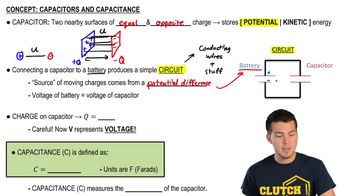26. Capacitors & Dielectrics
Capacitors & Capacitance
26. Capacitors & Dielectrics
Capacitors & Capacitance
Additional 2 creators.
Learn with other creators
Showing 5 of 5 videos
Practice this topic
- Multiple ChoiceWhat is the potential across a capacitor that is storing of charge?
- Multiple ChoiceTwo pieces of metal are connected to one another by a plastic rod. A student finds that when one has a charge of 12 nC, and the other has a charge of -12 nC, the potential difference between them is . What is the capacitance of the arrangement?
- Open QuestionA spherical capacitor contains a charge of 3.30 nC when connected to a potential difference of 220 V. If its plates are separated by vacuum and the inner radius of the outer shell is 4.00 cm, calculate: (a) the capacitance; (b) the radius of the inner sphere; (c) the electric field just outside the surface of the inner sphere.
- Open QuestionA capacitor is made from two hollow, coaxial, iron cylinders, one inside the other. The inner cylinder is negatively charged and the outer is positively charged; the magnitude of the charge on each is 10.0 pC. The inner cylinder has radius 0.50 mm, the outer one has radius 5.00 mm, and the length of each cylinder is 18.0 cm. (a) What is the capacitance? (b) What applied potential difference is necessary to produce these charges on the cylinders?
- Open QuestionA switch that connects a battery to a 10 μF capacitor is closed. Several seconds later you find that the capacitor plates are charged to ±30 μC. What is the emf of the battery?
- Open QuestionThe label rubbed off one of the capacitors you are using to build a circuit. To find out its capacitance, you place it in series with a 10 μF capacitor and connect them to a 9.0 V battery. Using your voltmeter, you measure 6.0 V across the unknown capacitor. What is the unknown capacitor's capacitance?






